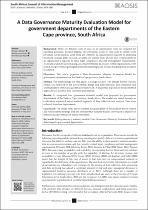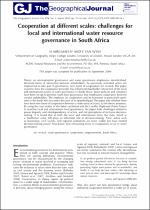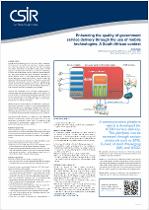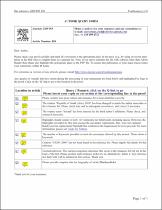 ResearchSpace
ResearchSpace
A Data Governance Maturity Evaluation Model for government departments of the Eastern Cape province, South Africa
JavaScript is disabled for your browser. Some features of this site may not work without it.
- ResearchSpace
- →
- Research Publications/Outputs
- →
- Journal Articles
- →
- View Item
| dc.contributor.author |
Olaitan, O

|
|
| dc.contributor.author |
Herselman, Martha E

|
|
| dc.contributor.author |
Wayi, N

|
|
| dc.date.accessioned | 2019-08-12T06:57:32Z | |
| dc.date.available | 2019-08-12T06:57:32Z | |
| dc.date.issued | 2019-07 | |
| dc.identifier.citation | Olaitan, O., Herselman, M.E., Wayi, N. 2019. A Data Governance Maturity Evaluation Model for government departments of the Eastern Cape province, South Africa. South African Journal of Information Management, vol. 21, No. 1, pp1-22 | en_US |
| dc.identifier.issn | 2078-1865 | |
| dc.identifier.issn | 1560-683X | |
| dc.identifier.uri | https://doi.org/10.4102/sajim.v21i1.996 | |
| dc.identifier.uri | https://sajim.co.za/index.php/sajim/article/view/996 | |
| dc.identifier.uri | http://hdl.handle.net/10204/11071 | |
| dc.description | Open Access article distributed under the terms of the Creative Commons Attribution License. | en_US |
| dc.description.abstract | Background: There are different uses of data in an organisation. Data are required for reporting purposes, decision-making and providing access to vital facts to enable work processes across business units. Data are central to an organisation’s capacity in anchoring fiscal and strategic plans on valid, accurate and current facts, and are also a vital element in an organisation’s capacity to meet legal, compliance and risk management requirements. To ensure sound decision-making, data must be treated as an asset within organisations, with sound data governance principles entrenched and employed for data handling from inception to deletion. •Objectives: This article proposes a Data Governance Maturity Evaluation Model for government departments of the Eastern Cape province, South Africa. •Method: The methodology for this study is Design Science. The Design Science Process Model, was followed in the development, design and demonstration, and evaluation and communication of the data governance framework. A sequential exploratory mixed-method approach was used for data collection and analysis. •Results: A conceptual data governance maturity model was proposed for government departments of the Eastern Cape province, South Africa. The model was tested through an exploratory sequential mixed-method approach of data collection and analysis. Data were collected from four departments. •Conclusion: The results of the survey confirm the applicability of the model in the set context and reinforced the findings from the literature that maturity models can be used to improve or enhance data governance in public enterprises. | en_US |
| dc.language.iso | en | en_US |
| dc.publisher | AOSIS | en_US |
| dc.relation.ispartofseries | Workflow;22549 | |
| dc.subject | Data governance | en_US |
| dc.subject | Data Governance Maturity | en_US |
| dc.subject | Data integrity | en_US |
| dc.subject | Evaluation Model | en_US |
| dc.subject | Government departments | en_US |
| dc.subject | Maturity models | en_US |
| dc.title | A Data Governance Maturity Evaluation Model for government departments of the Eastern Cape province, South Africa | en_US |
| dc.type | Article | en_US |
| dc.identifier.apacitation | Olaitan, O., Herselman, M. E., & Wayi, N. (2019). A Data Governance Maturity Evaluation Model for government departments of the Eastern Cape province, South Africa. http://hdl.handle.net/10204/11071 | en_ZA |
| dc.identifier.chicagocitation | Olaitan, O, Martha E Herselman, and N Wayi "A Data Governance Maturity Evaluation Model for government departments of the Eastern Cape province, South Africa." (2019) http://hdl.handle.net/10204/11071 | en_ZA |
| dc.identifier.vancouvercitation | Olaitan O, Herselman ME, Wayi N. A Data Governance Maturity Evaluation Model for government departments of the Eastern Cape province, South Africa. 2019; http://hdl.handle.net/10204/11071. | en_ZA |
| dc.identifier.ris | TY - Article AU - Olaitan, O AU - Herselman, Martha E AU - Wayi, N AB - Background: There are different uses of data in an organisation. Data are required for reporting purposes, decision-making and providing access to vital facts to enable work processes across business units. Data are central to an organisation’s capacity in anchoring fiscal and strategic plans on valid, accurate and current facts, and are also a vital element in an organisation’s capacity to meet legal, compliance and risk management requirements. To ensure sound decision-making, data must be treated as an asset within organisations, with sound data governance principles entrenched and employed for data handling from inception to deletion. •Objectives: This article proposes a Data Governance Maturity Evaluation Model for government departments of the Eastern Cape province, South Africa. •Method: The methodology for this study is Design Science. The Design Science Process Model, was followed in the development, design and demonstration, and evaluation and communication of the data governance framework. A sequential exploratory mixed-method approach was used for data collection and analysis. •Results: A conceptual data governance maturity model was proposed for government departments of the Eastern Cape province, South Africa. The model was tested through an exploratory sequential mixed-method approach of data collection and analysis. Data were collected from four departments. •Conclusion: The results of the survey confirm the applicability of the model in the set context and reinforced the findings from the literature that maturity models can be used to improve or enhance data governance in public enterprises. DA - 2019-07 DB - ResearchSpace DP - CSIR KW - Data governance KW - Data Governance Maturity KW - Data integrity KW - Evaluation Model KW - Government departments KW - Maturity models LK - https://researchspace.csir.co.za PY - 2019 SM - 2078-1865 SM - 1560-683X T1 - A Data Governance Maturity Evaluation Model for government departments of the Eastern Cape province, South Africa TI - A Data Governance Maturity Evaluation Model for government departments of the Eastern Cape province, South Africa UR - http://hdl.handle.net/10204/11071 ER - | en_ZA |








